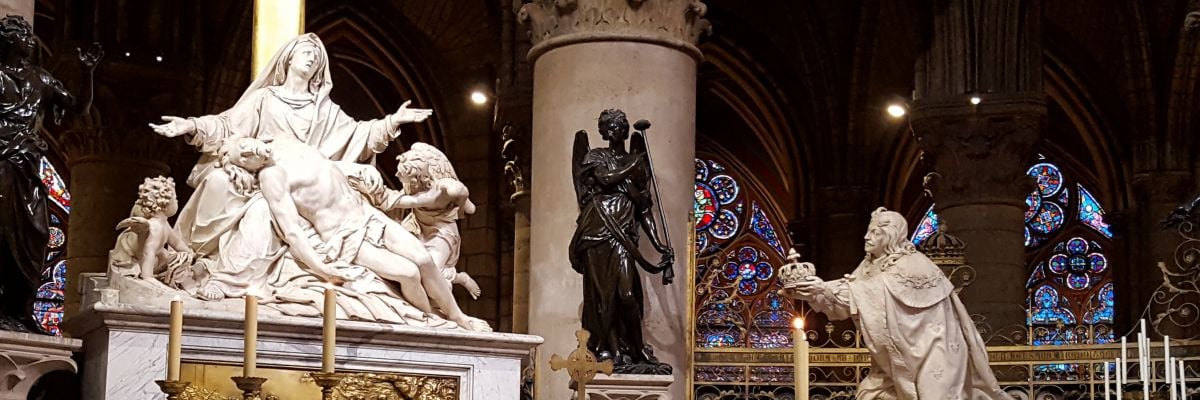
When the magnificent Cathedral of Our Lady (Notre Dame) in Paris caught fire earlier this week, the world was mesmerized by the apparent destruction of such an historical and holy edifice—one of the most widely recognized and frequently visited structures in the world.
Although the soaring Gothic cathedral is well known, until recent events relatively few people knew that it has been home to the holy relic of the Crown of Thorns worn by Christ during his Passion. The destructive fire sharpened the world’s focus on the cathedral, Paris, and the Catholic Church at the beginning of the holiest week of the year and, in God’s own providential way, made more widely known the existence of this singular relic.
It has also aroused skepticism and questions. How did one of the central relics of the Passion end up in the capital of France? How do we know this relic is authentic? Isn’t it more likely some pious myth?
The story of the arrival of the crown in Paris is a dramatic tale of the sacking of a majestic city, a bankrupt empire, and a saintly monarch desirous of manifesting leadership of Christendom in medieval Europe.
Three of the four Gospel narratives record that Jesus, during his Passion, was crowned with thorns by Roman soldiers (Mark 15:17, Matt 27:29, John 19:2, 5). However, documentary evidence for the crown’s whereabouts after the Crucifixion are scarce until the fifth century, when the Gallo-Roman bishop St. Paulinus of Nola (354-431) referenced the relics of the crown and the cross in his writings. A century later, the Roman senator and later monk Cassiodorus (c. 490-585) mentioned the relic of the crown of thorns in his commentary on Psalm 86.
Another sixth-century reference is found in the travel diary of the anonymous Pilgrim of Piacenza, a Christian from Italy who went on pilgrimage to the Holy Land, who wrote, “There is in that church [the basilica Church of Hagia Zion] also the crown of thorns with which the Lord was crowned.” From the sixth to the tenth centuries, there are reports of the distribution of thorns from the crown to various persons including St. Germanus (c. 469-576), the bishop of Paris; Charlemagne (742-814), king of the Franks and holy roman emperor; and the Anglo-Saxon king Æthelstan (894-939). It is believed that sometime in the mid-eleventh century the crown was transferred from Jerusalem to Constantinople, where it remained for nearly two centuries.
In the thirteenth century, Robert de Clari (1170-1216), a French warrior who participated in the Fourth Crusade (1201-1205), provided a description of his Crusade activities. He describes in his chronicle the multitude of precious objects and sacred relics contained within the majestic city of Constantinople:
Within this chapel were found… two pieces of the true cross… two nails that were driven through the midst of his hands and through the midst of his feet. And there, too, was found the blessed crown wherewith he was crowned, which was wrought of sea rushes, sharp as dagger blades.”
The Fourth Crusade, in 1204, resulted in the sack of Constantinople, which Pope Innocent III (r.1198-1216) condemned, and the establishment of a Latin Empire (called “this new France” by Pope Honorius III and colloquially known as “Romania”) that lasted until 1261. The Latin Empire faced significant challenges in its short existence, including the presence of exiled Byzantines, who wanted their imperial capital back, and a lack of western military manpower. Many westerners left the Holy Land and settled in Latin-controlled Constantinople, which ultimately weakened Christian-controlled territory in the Latin East (Acre, one of the last major Christian cities in the Holy Land, fell to a Muslim army in 1291).
The last Latin emperor to rule in Constantinople was Baldwin II (r. 1228–1273), who was also the only Latin emperor born in the city. Faced with significant financial difficulties, Baldwin embarked on a tour of western Europe in a recruitment campaign for men and money. While in France, Baldwin received word that his barons had borrowed money from the Venetians and used the crown of thorns as collateral. He begged King St. Louis IX (1214–1270) to help him repay the loan to prevent the transfer of the precious relic to Venice. In return, Baldwin promised to gift the crown of thorns to Louis.
The saintly monarch envisioned France as a new Holy Land, and what better way to manifest that vision than with possession of the relics of the Lord’s Passion. The king earnestly believed that the offer from Baldwin was providential and agreed to provide the funds to the young emperor. King Louis sent two Dominicans (Jacques and André), one of whom had spent time in Constantinople and could verify the authenticity of the relic, with a royal letter to the imperial city. The royal messengers arrived on June 17, 1238, one day before the loan’s due date. The Venetians, disappointed that the prized relic would not permanently reside in their city, honored the king’s payment with the condition that Louis allow the crown to travel to Venice for a period of veneration by the inhabitants of the republic. Louis agreed to the request, and, in 1239, the crown was transported across the sea to Venice, where it was received with much adulation.
That same year, the relic began the overland journey to France. Miraculous occurrences were reported during its journey to Louis’s kingdom, including weather phenomena wherein no rain fell when the relic was transported by day but torrential rains when it was safely inside at night. The king planned to accompany the crown into Paris (along with his mother, brothers, several bishops, barons and knights), meeting it ninety miles away at the town of Villeneuve-l’Archevêque.
From there, the king and his entourage began a penitential procession to Sens, which welcomed the relic with great fanfare. Clerics brought out the city’s collection of saint relics to welcome the crown amid the ringing of church bells and the sound of organs. The relic’s journey of continued via the Yonne River from Sens to Vincennes over several days. As they neared Paris, Louis and his brother Robert carried the crown of thorns into the city barefoot, each wearing a single tunic. Once inside the city, the king took the crown to Notre Dame Cathedral for a brief period before its arrival at the royal palace, where it was placed in the Chapel of St. Nicholas.
Recognizing that such a holy relic should not remain in a small palace chapel, King St. Louis IX ordered the construction of a special chapel on the Île de la Cité, near Notre Dame. The Gothic style chapel, known as Sainte-Chapelle (Holy Chapel), containing fifteen exquisite stained glass windows that depict 1,113 scenes from the Bible, was consecrated on April 26, 1248.
The crown of thorns remained in Sainte-Chapelle for over 500 years until the French Revolution, which saw the crown removed to the National Library for several years until the archbishop of Paris received it back with the signing of the Concordat of 1801 between Napoleon and Pope Pius VII. Subsequently, the crown was placed in Notre Dame. Encased in a jeweled rock crystal reliquary and containing only a circlet of rushes and no thorns, the relic was displayed on First Fridays of the month and Fridays during Lent, including Good Friday when the faithful were allowed to venerate it.
Although the fire destroyed the spire and wooden roof of the almost 900-year-old cathedral, a courageous priest, Fr. Jean-Marc Fournier, rescued the crown, along with other holy relics and the Blessed Sacrament, from the blaze. Let us hope and pray that the renewed interest and knowledge of Notre Dame Cathedral and the crown of thorns caused by the great fire of 2019 might bring a resurgence of faith to France—the Eldest Daughter of the Church—and the whole world.
Image: High altar statues at Notre-Dame Cathedral, Paris.



